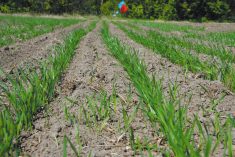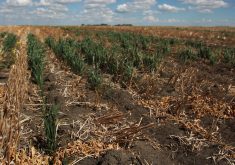Canola prices have soared this season and have mostly divorced from their usual connections with the soybean complex.
It’s no surprise November canola futures last week closed at a contract high of about $927 per tonne given an estimated national average yield of only 25.3 bushels and acres, the lowest since 2002 due to drought and heat.
The November contract soared in July along with the mercury and lack of rain and has since fluctuated between about $845 to $925.
But November soybeans peaked June 7 and have since fallen as weather improved in the Midwest, increasing prospects for the crop in the United States.
Read Also

August rain welcome, but offered limited relief
Increased precipitation in August aids farmers prior to harvest in southern prairies of Canada.
The price was further weakened when the U.S. Department of Agriculture’s Sept. 1 quarterly grain stocks report pegged soybean stocks at 256 million bu., significantly higher than the average of the trade’s expectation of 174 million.
The November soybean price is now the lowest since last December and the December soy meal contract is the lowest in a year.
Two connected factors weighing against soybeans are the weakness of soy meal and concerns about Chinese demand for imported beans.
There are conflicting views about China’s demand.
Some analysts note that China’s hog sector is again staggering following a rebound earlier this year. African swine fever has made a comeback leading to increased herd culling that is pushing pork supply up and pork prices lower. That has driven hog prices below break-even margins and producers are losing money.
Also, hog feeders are using more feed wheat in their rations to take advantage of the country’s still large stockpiles of that grain and that cuts down on the amount of soy meal in the diet.
Complicating the situation further, China is suffering electricity shortages. As its economy bounces back from the pandemic, its electricity demand is rising just as it tries to curb its reliance on greenhouse-gas-producing coal in generating electricity. And natural gas, an alternative fuel, is in short supply, causing its price to soar.
Authorities are limiting power to a range of industries, from metals to fertilizer and even soybean crushing plants.
U.S. soybean and soy meal shipments to China have also been hampered in recent weeks as Gulf of Mexico ports repair damage caused by Hurricane Ida, and on the West Coast, a collapsed crane damaged a soy meal export facility.
All of this together would lead us to believe there will be fewer soybeans going to China over the next few months and that is important because that country accounts for 60 percent of global soybean imports.
However that is not the view of the USDA’s attaché in China.
Its September oilseed update noted the decline in the hog sector but said the effect should be offset as China’s swine industry continues to shift from small backyard farms feeding scraps to huge commercial operations that favour commercial compound feed, which includes soymeal.
Also the poultry industry is growing and requiring more soy meal.
The report forecasts China’s 2021-22 soybean imports to rise to 101 million tonnes, up three million from the year before.
Which of these conflicting forecasts is correct will be decided by the pace of weekly exports out of the U.S. American soybean shipments to China increase in the fall as the harvest comes in and supply from South America winds down as its marketing year moves toward its end.
The oil part of the soybean complex usually has less influence on soybean prices because it makes up a smaller portion of the seed.
But this year will see shortages of competing vegetable oil, specifically canola oil, so soy oil along with other vegetable oils could see strong prices.
After a sleepy summer, soy oil futures started rallying in late September.
The rally was supported by rapidly rising crude oil prices, which are reacting to the global shortage of natural gas and the Organization of Petroleum Exporting Countries unwillingness to increase its post-pandemic production.
When the pandemic staggered the global economy, OPEC steeply cut production. It is now building back up by 400,000 barrels a month, but that is not keeping up with rising demand.
From a summer low of US$65 per barrel Brent crude, the international price benchmark, has risen to more than $80 and investment bank Goldman Sachs forecasts it could climb to $90 by year’s end.
Some bulls are even forecasting a spike to $100 if the Northern Hemisphere winter is colder than normal.
That would also support vegetable oils that can be used in biofuel.
Indeed the Malaysian palm oil price last week surged to a record high.
And that adds further support to canola prices that are high anyway because of the small crop.















